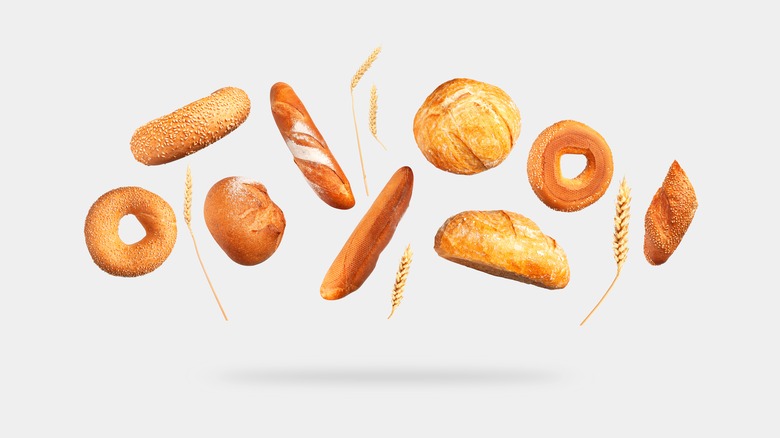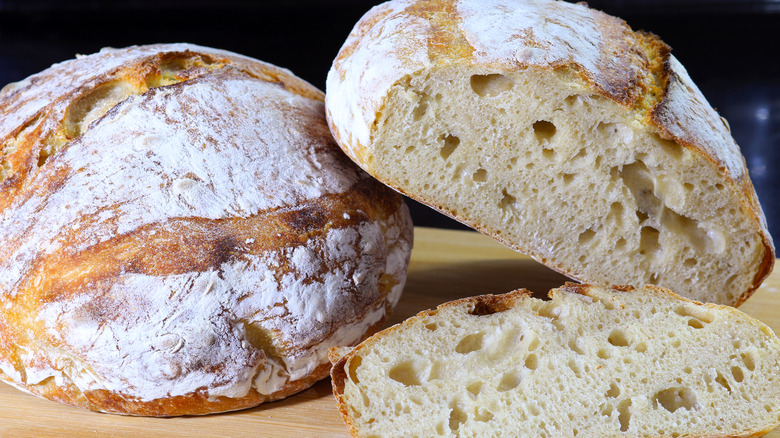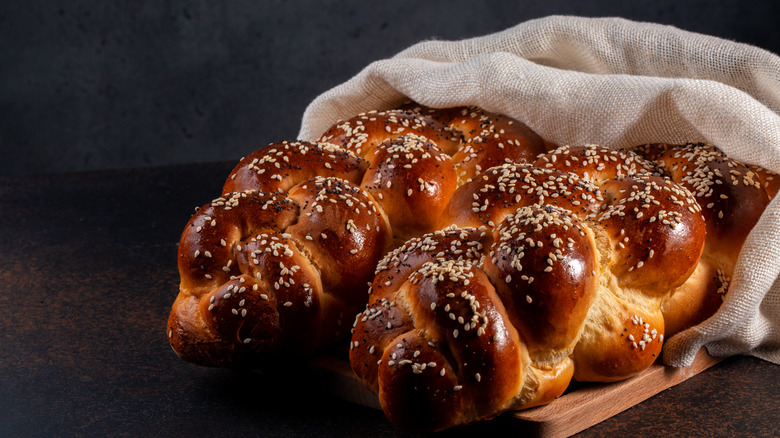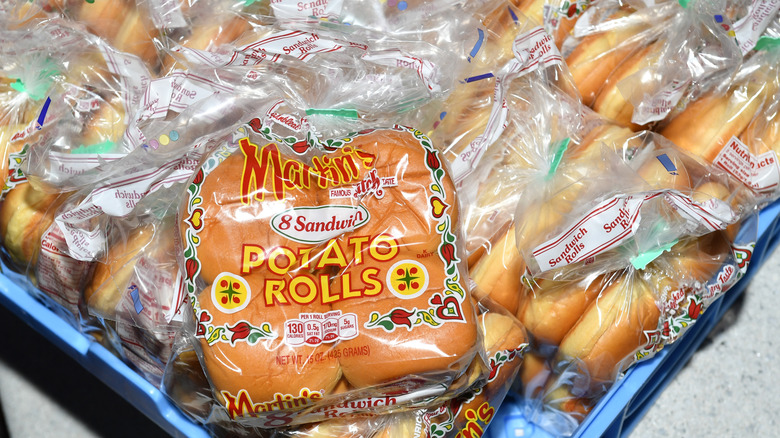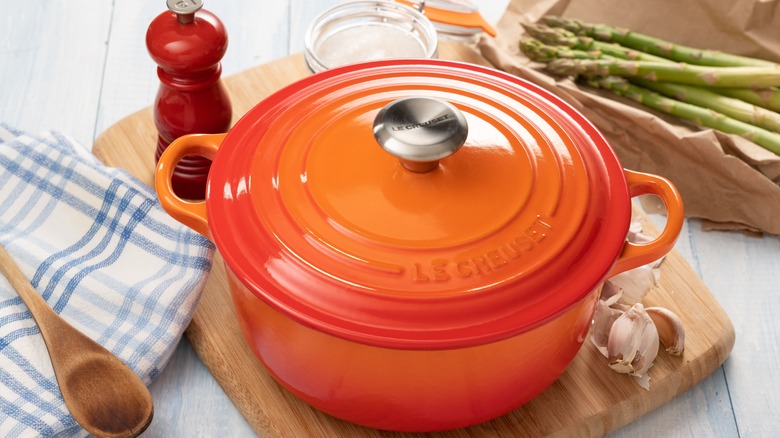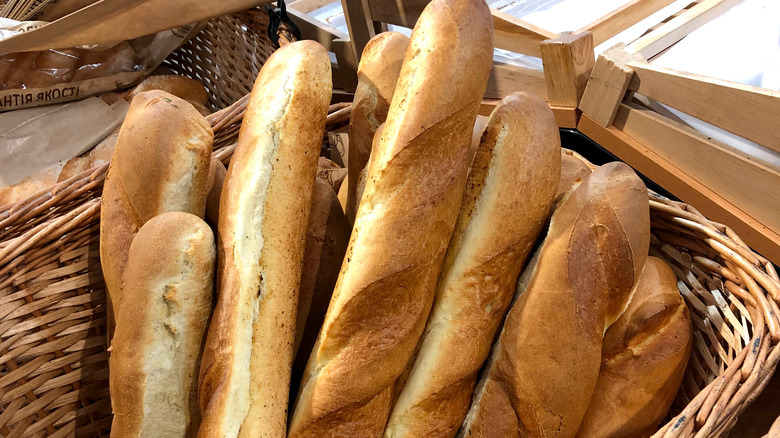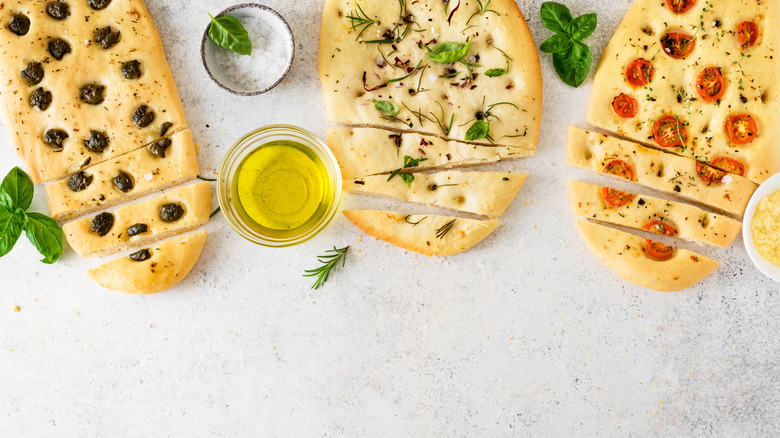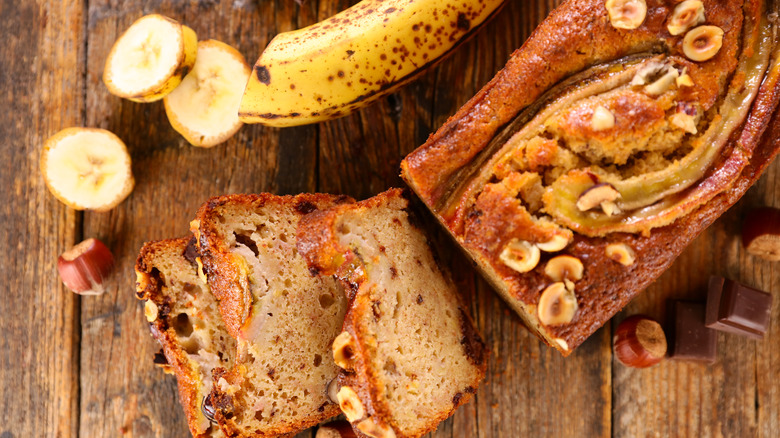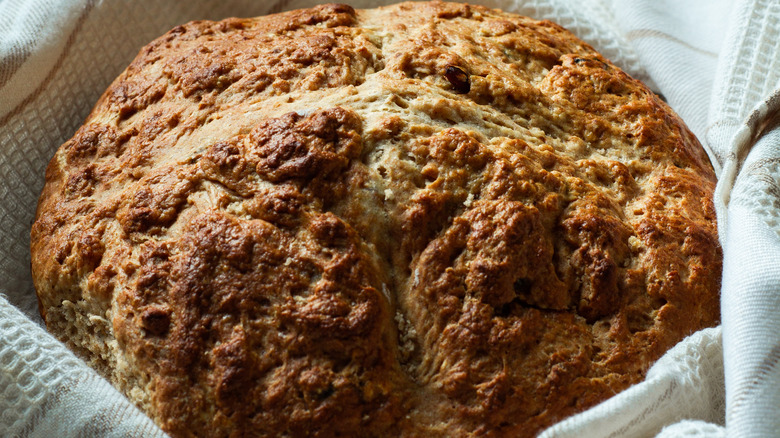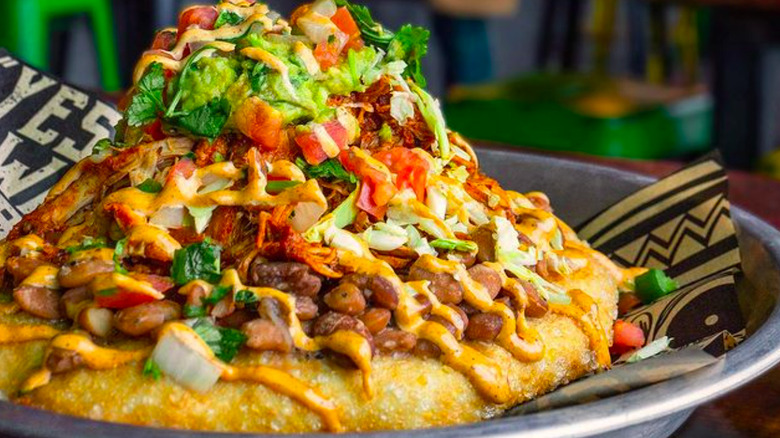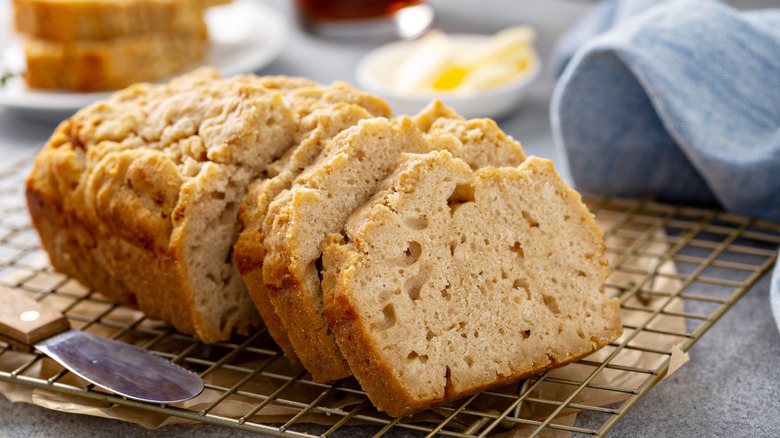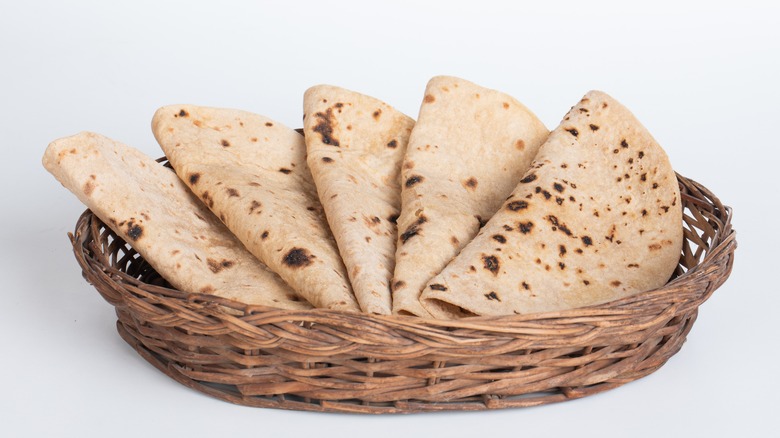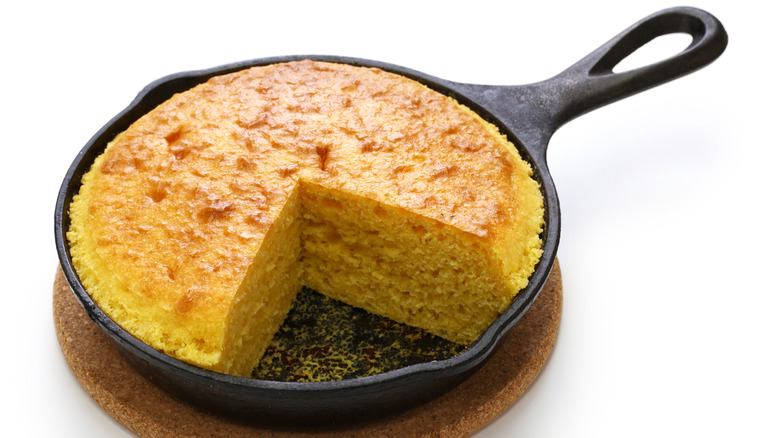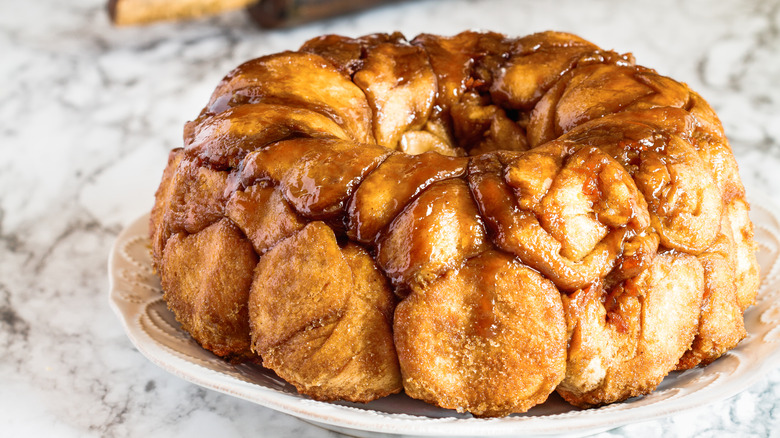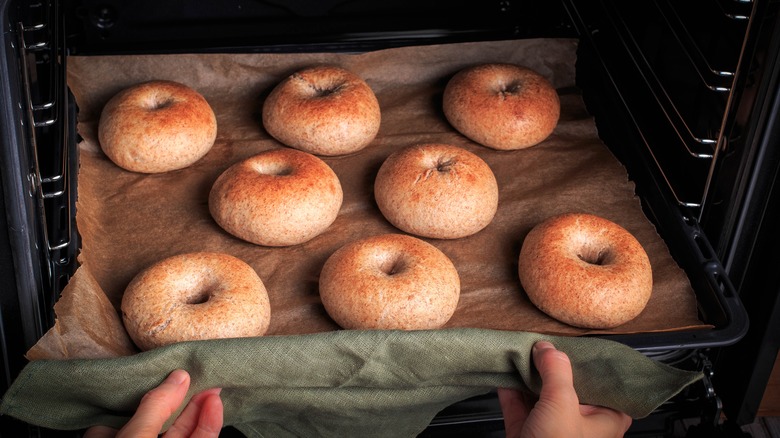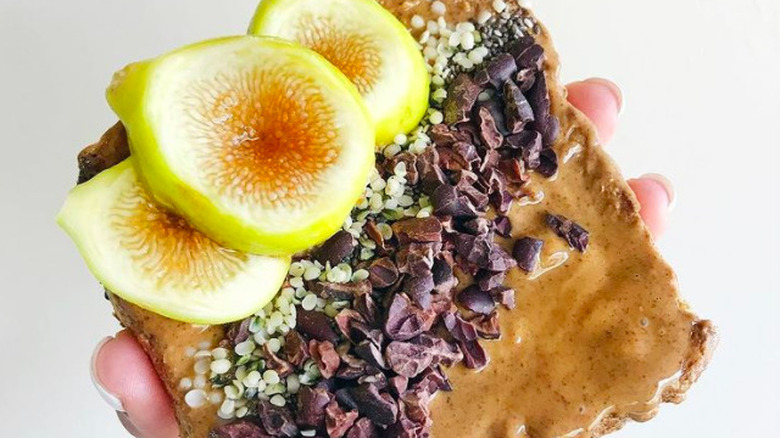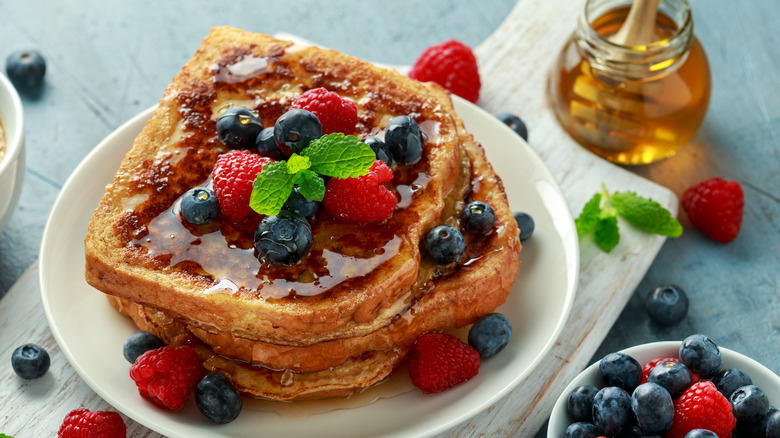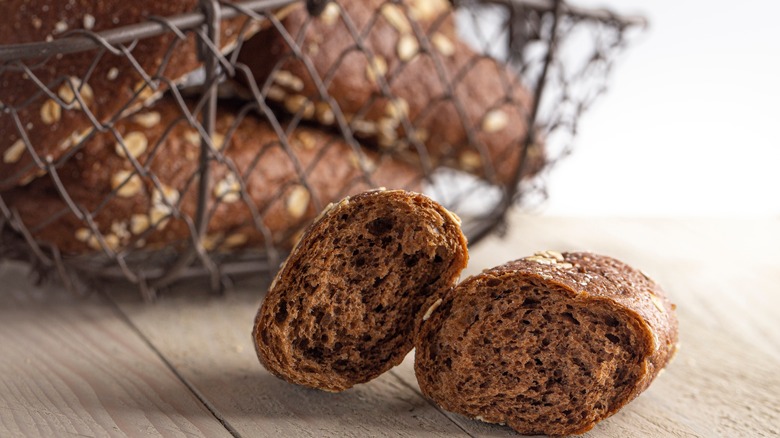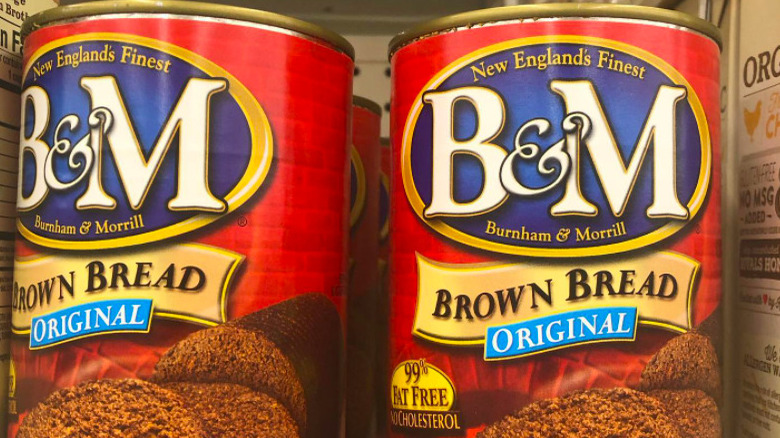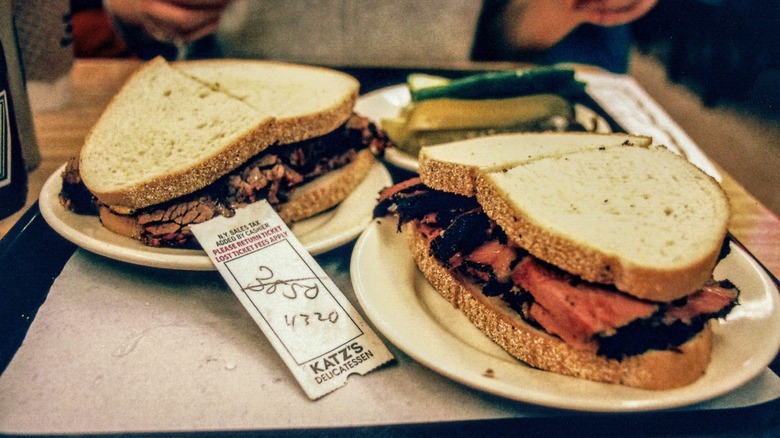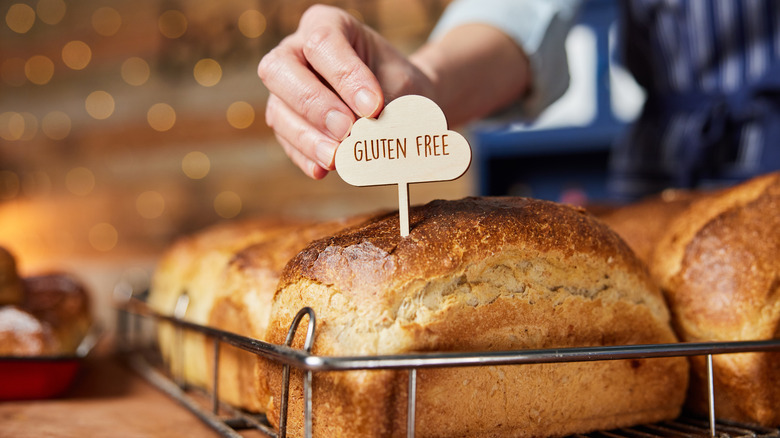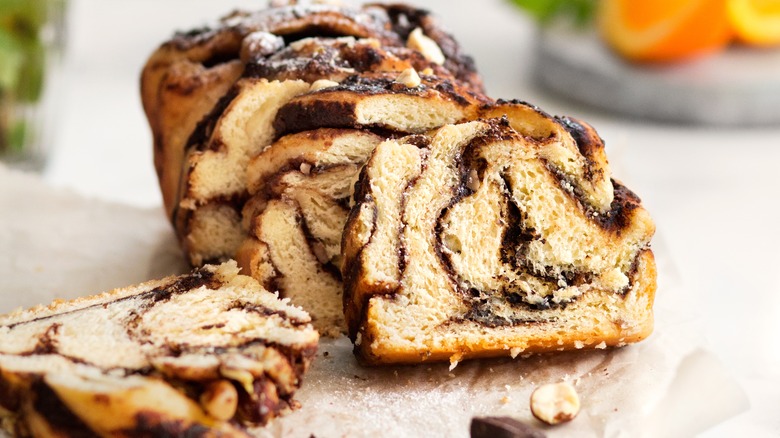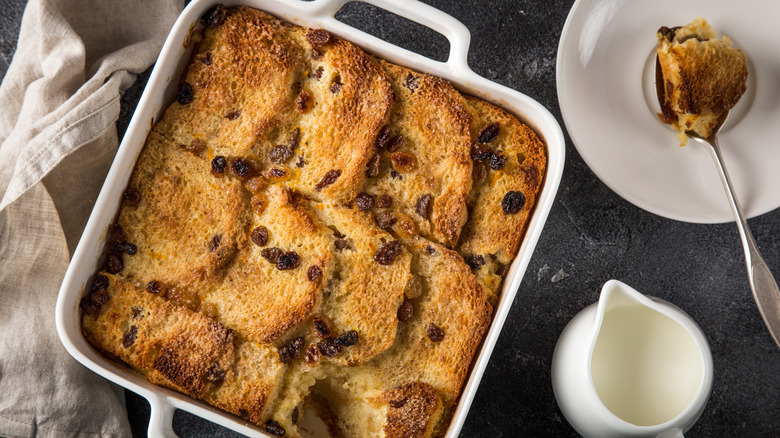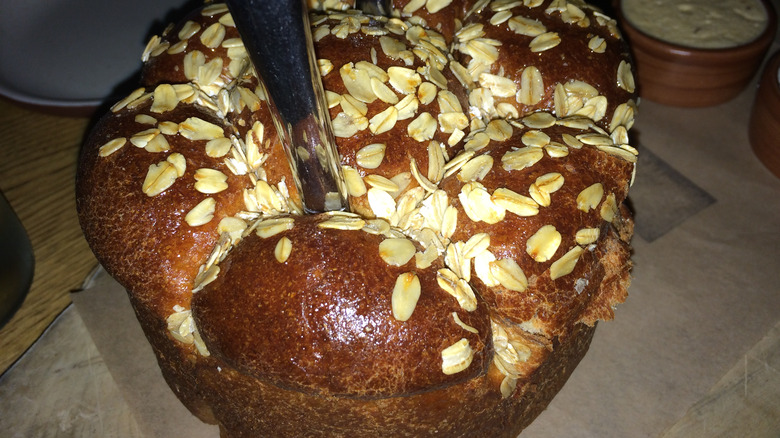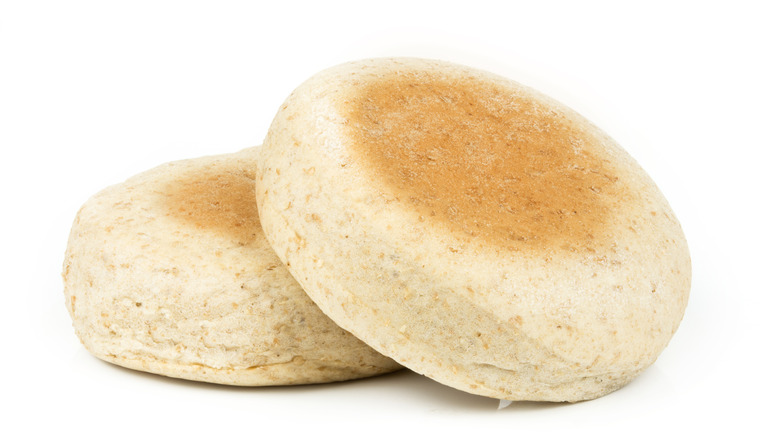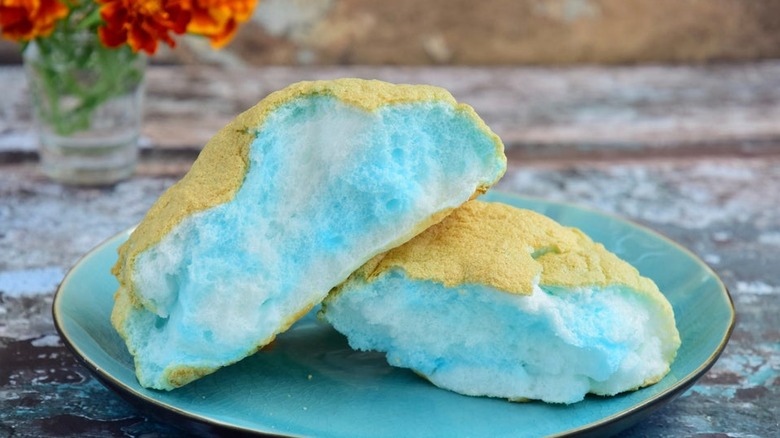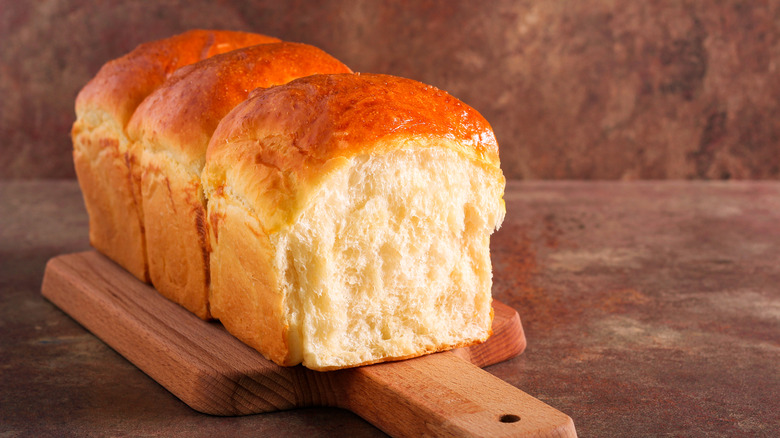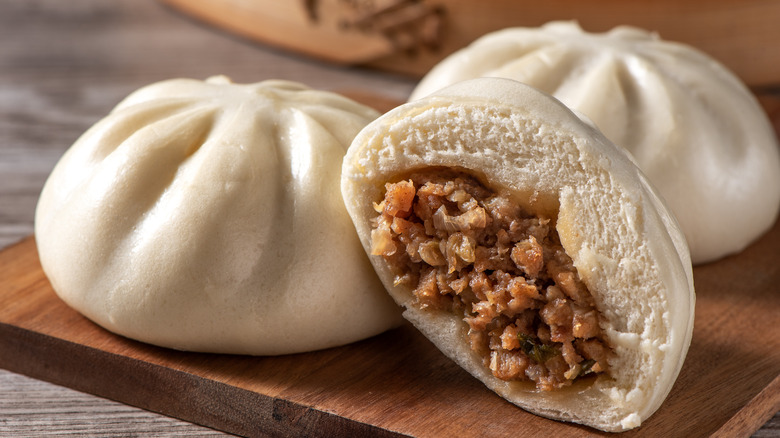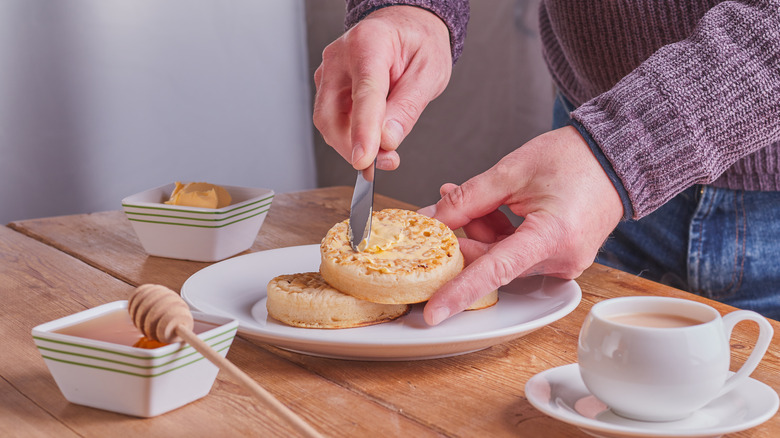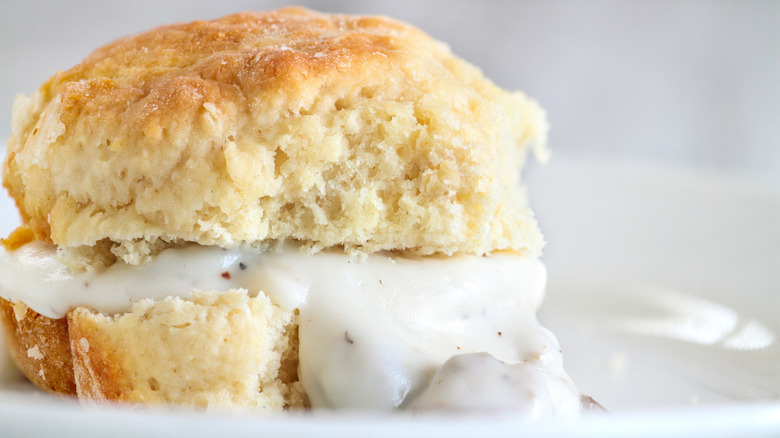30 Types Of Bread, Explained
Bread is a worldwide dietary component in a variety of cultures. It is typically moistened with water before being fermented, kneaded, shaped, and baked. The ingredients and methods for each type of bread differ based on geography and culture. Some types of bread are born out of social and political change, such as indigenous American fry bread or French bread, while others are born out of tradition and celebration, like Italian Panettone or Jewish challah. Here are the historical and scientific roots of popular types of bread across the globe, many of which can still be found in breadbaskets and supermarkets today!
1. Sourdough bread
According to King Arthur Baking Company, a culture of bacteria is critical to forming sourdough bread. The bacteria, which are found naturally in the flour and on almost all kitchen surfaces, feed on a mixture of flour and water — this mixture is referred to as a sourdough starter. Once the yeast settles and starts to eat the starches in the starter, it produces carbon dioxide bubbles (the distinctive flavor of sourdough bread). The exact flavor of the sourdough is dependent on the types of wild yeast present and the type of flour used in the starter.
Making your own sourdough starter at home is easy. To start, mix 1 cup of flour with ½ cup of warm water in a glass. Cover with a light cloth. King Arthur Baking Company recommends using whole wheat flour, like pumpernickel or whole wheat, because it is more likely to house a rich collection of wild yeasts. The mixture needs to remain in a warm environment to stimulate growth. After 24 hours, discard ½ of the mix, add 1 cup of all-purpose flour, and pour in ½ cup of lukewarm water. Stir, cover, and repeat for the next two-to-three days. By the fifth day, you should be able to change the mixture every 12 hours.
The sourdough is "ripe" when it doubles in size every six-to-eight hours and appears bubbly. Use the discarded sourdough for bread recipes, bagels, or pancakes.
2. Challah bread
Challah is both a physical and metaphorical centerpiece for the Jewish rest day Shabbat. According to The Nosher, challah was originally said to be the bread presented to the kohen (Jewish priest) as an offering from Moses. Moreover, the most common shape of the challah, a braided strand with 12 humps, signifies the 12 ceremonial loaves kept in the Temple of Jerusalem for the 12 tribes of Israel.
Challah has also carried immense social weight in Jewish culture. A long, more intricate challah symbolized wealth and status. Modernist Bread notes the challah baked for Rosh Hashanah is typically the most intricate style. Its roundness and inclusion of raisins or dried fruit symbolize a plentiful year and upward social progress.
The original challah was not as sweet as the kind used in American diner challah french toast: The Americanization of challah included abundant sugar, eggs, and poppy seeds. Challah also grew in size with the rise of commercially available yeast in bakeries and homes during the early 20th century.
3. Potato bread
Potato bread was initially a food born out of scarcity and substitutions. IFoodTV credits Frenchman Antonie-Augustin Parmentier for creating the first potato bread recipe and promoting the tuber as the "poor man's vegetable." Its American roots date back to the mid-18th century when early Revolutionaries added potatoes (either as potato flour or mashed potatoes) into bread to limit the use of expensive wheat in the household. According to Revolutionary Pie, in New England, potato rolls were called "featherbeds" for their light, airy qualities.
Potato bread has many of the same ingredients as other breads like flour, yeast, oil, and water — just with the addition of mashed potatoes. Different cultures around the world add varying ratios of potatoes to wheat flour, notes iFoodTV. For example, Kartoffelbrot, German potato bread, contains rye flour, potatoes, and spelt. Pratie Oaten, from Ireland, is a traditional Irish bread made from potatoes and oatmeal.
4. Dutch oven bread
Dutch oven bread is that simple: It's bread made in a Dutch oven. Dutch oven bread-making is just one reason why you need a Dutch oven; it can also be used for soups, stews, and bakes. Food scientist J. Kenji López-Alt notes that the Dutch oven is an ideal vessel for baking bread because it traps the steam produced as the bread bakes. This gelatinizes the starch layer on the outside of the bread, resulting in a springy bread with a crunchy crust.
Dutch oven bread was most recently popularized with a rise in home baking during the beginning of the COVID-19 pandemic. The LeCreuset Dutch oven bread recipe calls for 4 cups of flour, 1½ cups of water, active dry yeast, salt, and vegetable oil spray. The rest period for this dough is especially long at more than 4 hours. Dutch oven bread is an ideal bread for first-time bakers because of its simplicity and the sheer pleasure of devouring the bread after it's baked.
5. French bread
Bread is an integral part of French culture. Busby's Bakery notes that between 60% and 80% of the average French person's diet in the 1700s was comprised of wheat products. During the French Revolution, the quality and price of bread were markers for mounting social inequity. Lawmakers soon passed the "bread of equality" legislation to regulate wheat prices and expand access to wheat across France. This expansion, coupled with legislation that limited the working hours of French bakers, meant that bakers were searching for bread that was thin enough for a relatively quick bake but also crisp enough that it would sell quickly. Thus, the baguette was born!
6. Italian bread
The Italians have been given immense historic credit for their role in wheat manufacturing per Garrubbo Guide. The Romans were the first society known to mill flour, as well as the first group to open a baking school. Italian bread is characteristically large, as bread is an integral part of feeding the Italian family.
The most well-known varieties of Italian bread include ciabatta, focaccia, and panettone. Ciabatta is broad, long, and flat with a slight collapse in the center. The texture includes a crunchy crust and soft, porous inside. Focaccia is a close relative of pizza dough seasoned generously with olive oil and salt. Focaccia can include olives, rosemary, garlic, tomatoes, and fresh herbs. Panettone is a sweet bread. It is typically only eaten on Christmas Day and takes several hours of preparation to rest and shape the dough into a cupola (cylindrical base). Panettone flavors are often distinctively sweet and indicative of the region of origin — such as raisins, candied citrus, and even chocolate.
7. Quick bread
Unlike other types of bread, quick bread does not contain yeast. Quick bread surged in popularity in the 19th century due to the advent of baking soda and baking powder. These leavening agents could replace not only the flavor of yeast, but also the time it took to rest, proof, and bake yeasted bread. According to Baking Kneads, synthetic leavening agents also produced more reliable results than yeasted breads. Popular quick breads include banana bread and English crumpets.
Working with quick breads can be slightly more precarious than with yeasted breads. The leavening agents produce carbon dioxide rather quickly, so the baker needs to move the bread into the oven without beating out too much of the rising power. Quick breads also have a comparatively lower gluten structure, so the dough cannot hold onto the carbon dioxide as easily as it can with a yeasted dough.
One of the most recommended methods for working with quick bread is to separate the dry and wet ingredients until the bread is about to go in the oven. This tip, along with avoiding over-mixing, will result in a fluffier quick bread.
8. Irish soda bread
Soda bread is technically classified as quick bread, but its connection to Ireland makes it deserving of a category of its own. According to The Real World, the technique of using an alkaline powder to leaven bread was attributed to the Native American's use of pearl ash. The Irish replicated the process using conventional baking soda once it was invented in the mid-19th century.
The four critical ingredients for soda bread are wheat flour, salt, baking soda, and buttermilk. The rural Irish's access to open hearths, iron pots, and griddles also led to the formation of a dense bread with a hard crust. Moreover, the shaping and slicing of the soda bread into triangles is indicative of regional culture, but also tied to myths that making a cross on the top of the bread would ensure sanctity for the household.
Modern Irish soda bread contains a diverse mix of sweet and savory additions including caraway seeds, honey, or raisins. Some varieties are even flavored with treacle and Guinness!
9. Fry bread
Fry bread was an indigenous American bread born out of forced dislocation and systemic injustice. In an article by Smithsonian Magazine, Navajo families recount the "Long Walk," a movement of their people from their land in Arizona to New Mexico. The new land was not able to sustain endemic crops like beans, so the United States government supplied them with white flour, cane sugar, and lard. These ingredients were fried to produce a funnel-cake consistency filled with air bubbles and grease.
The Oklahoma Historical Society notes that fry bread varies in toppings and accompaniments. It can be topped with sweets, pumpkin, or chocolate.
The commercialization of fry bread has not come without controversy. Although some indigenous entrepreneurs sell fry bread mixes as a way of economic opportunity, many non-indigenous folks sell fry bread, which was once a symbol of stolen land, dislocation, and dominion, as a way to profit from the indigenous culture without being a member of it themselves. If you are looking to try fry bread for yourself, prioritize purchasing it from an indigenous-owned vendor.
10. Beer bread
Beer bread's history is rooted in quick bread and soda bread, according to VinePair. As noted prior, un-yeasted bread does not often have the same lift capacity because of the short life of the carbon dioxide within the bread structure. Beer can provide a fizzy boost of carbon dioxide to help the bread become lighter and fluffier.
Folks who make beer bread would describe its taste as somewhat hoppy. Altering the type of beer used in the bread can change the flavor of the bread significantly. One beer bread recipe uses a standard lager but can be substituted for a pumpkin lager in the fall. Adding an oat crust to the exterior of the beer bread could also pair well with an oatmeal stout.
To make beer bread at home, combine flour, baking powder, salt, and brown sugar separately from the melted butter and beer. Once ready to bake, combine the wet ingredients into the dry, mix, and bake. The result is a delicious beer bread that takes less than an hour total to make!
11. Flatbread
Flatbread's name is a clear clue to its qualities. This unleavened bread class, which includes naan, tortillas, pita, and roti, was geographically linked to the Fertile Crescent (which is now the modern-day Middle East) according to the Journal of Ethnic Foods. Cultures endemic to this region used flatbreads as a means of sustenance for several reasons. The first is that their ingredients could include cereals, legumes, and pseudo-cereals besides wheat; this meant the recipe was adaptable to whatever ingredients were present. Flatbreads also do not require an oven to be baked — meaning that they could be cooked using sand or hot rocks while the nomadic people were moving from place to place. The thickness of the bread, which can range from a few millimeters to a few centimeters, was also stackable in bags so it could easily be moved between locations.
Cultures have adapted flatbread to local ingredients and cuisines. Indian roti, as noted by The Food Charlatan, is an unleavened bread that is often buttered with ghee and served with curry.
12. Cornbread
The Institute of Culinary Education claims cornbread is a distinctly American bread with roots intersecting race, region, and class. Indigenous Americans relied on corn as a dietary staple and developed numerous corn products including corn pone: a mix of cornmeal, salt, and water. The Discover South Carolina notes that cornbread containing buttermilk, sugar, and eggs was often indicative of a wealthier household. Households and commercial entities alike have altered the cornbread recipe for regional fares to include bacon, vegetables, and cheese. The batter can be made as a pancake or as a cake in a cast iron skillet.
According to Kiddle, there are numerous regional cornbread variations. Johnnycakes are a thin, New England cornbread cake fried on a hot greased griddle. Hushpuppies are a Southern buttermilk-based batter fried and served with fish. These balls are most commonly crunchy on the outside and soft and pillowy on the inside.
13. Monkey bread
According to food historian Gil Marks, monkey bread was popularized in Southern California during the 1940s. The yeasted, soft bread was originally savory in nature and accompanied by jam or preserves. The bread is easily pulled apart without the use of a knife because it is assembled by dipping pieces of dough into butter and fitting them into a baking pan with one another. In the 1970s, the bread became sweeter with the use of dipping sugar. Monkey bread also goes by other names: Hungarian coffee cake or golden dumpling cake.
Although its name suggests that this bread has something to do with primates, it is actually more so the likeness between the baked bread and a barrel of monkeys. Other food historians believe the bread's name stems from the combination of 1940s Southern slang for snack food ("monkey food") and jumble bread (piecemeal bread made in a pan).
14. Bagels
Bagels are not only the base of greasy breakfast fare, but they are also a prime example of why bread science is so cool. According to NPR, bagels are poached in water before baking. The chilled dough rings are boiled for between 30 seconds and three minutes before being extracted from the water and placed into the oven to bake. The water is typically seasoned with baking soda, barley malt, or lye for flavor and coloring, according to Between Rounds. Boiling gelatinizes the starch on the exterior of the bagel — resulting in a crispy and satisfying crunch. Many commercialized bagels are instead cooked in a steam oven which only reaches the surface of the bagel. The result is a less satisfying, puffier bagel with a thinner crust.
15. Sliced bread
According to the History Channel, sliced bread was commercially produced in 1928 in Missouri and popularized by Wonder shortly afterward. Significant advances in food science have improved the shelf-life of sliced bread, as well as its efficiency on the line. American consumers can purchase a variety of sliced bread, including white, wheat, and thick-sliced Texas toast.
Sliced bread thickness varies based on region, according to Gold Medal Bakery. In the United States, the average sliced bread loaf is between 20-to-24 slices and less than ½ inch thick. In contrast, the Japanese sliced bread loaf is four-to-10 slices. These slices are used mostly for toast rather than sandwiches so they are significantly larger than the American version. Additionally, Japanese sliced bread typically only comes in one variety, white.
16. Sprouted grain bread
An article published by the Harvard Medical School explains that sprouted grains are harvested during the germination process. These sprouts have more nutrients and minerals like folate, magnesium, iron, and vitamin C bioavailable for humans to digest. Sprouted grains also have less starch than traditional grains, so they pass more easily through the gastrointestinal tract.
Popular brands of sprouted grain bread include Food for Life, Angelic Bakehouse, and Dave's Killer Bread. These bread brands can easily be frozen to extend their shelf-life. Top your favorite sprouted grain bread with nut butter, fruit, mashed avocado, or hummus. Or, pack a sandwich with your favorite fillings for a day at the beach.
17. French toast
According to an article published by The Breakfast Shoppe, French toast was first created by the Romans in the fifth century. The dish, called pan dulcis, was bread soaked in milk and eggs and promptly fried in butter or oil. The Medieval societies soaked their bread in egg and milk to both extend the use of stale bread and to provide more fat and protein. The namesake, "French toast," was coined by Joseph French in 1724 because he had forgotten to add the apostrophe.
French toast can be made using almost any type of bread including brioche, sandwich bread, or panettone. It can also be made as a casserole by placing the soaked bread in the fridge overnight and baking in the morning.
18. Brown bread
Brown bread is uniquely a New England food. Brown bread is frequently served as an accompaniment to baked beans and hot dogs. According to Atlas Oscura, brown bread gets its flavor and texture from a mix of cornmeal, rye, and wheat flour. The color primarily comes from molasses.
When brown bread was first baked, New England's climate was not hospitable enough to grow wheat as a sole grain. Early colonists grew corn and rye to supplement their wheat supply. Molasses was a byproduct of sugar production in the South, so the New England colonies had a plentiful supply of molasses for rum — and apparently brown bread, too.
19. Canned bread
Besides baking loaves of brown bread, New England colonists also experimented with preservation techniques to extend the life of their food supply. Canning maintains the moisture and seals bacteria out of the food product. According to Today, B&M foods began manufacturing canned brown bread in 1928 along with its array of canned carrots, beans, and vegetables. Sales of canned bread increased significantly during World War II when food supplies were limited.
According to those who have tasted canned bread, its texture is similar to zucchini bread — just without the zucchini. Along with canned beans, canned bread can be eaten with a slab of butter or cream cheese for breakfast.
20. Rye bread
Rye was grown as an alternative to wheat in Northern Europe during the 12th century, according to the Great Basin Bakery. Also, The New York Times notes that the grain favors cold, wet climates, so it could grow more plentifully in Germany, the Baltic region, Russia, and Scandinavia. Its long fermentation time and resulting sour taste caused many farmers in Scandinavia to grow rye instead for animal feed or as a cover crop. However, some iterations of the bread stayed alive like smorrebrod — a Swedish open-faced rye sandwich with herring, smoked salmon, or smoked cheese.
In Ukraine and southern Poland, bakers used caraway, anise, fennel, and coriander seeds to season their rye bread. Sissel rye (sissel is Yiddish for caraway) spread across America with the Jewish migration. Jewish delis began using rye for their pastrami, smoked salami, and chopped liver sandwiches.
21. Gluten-free bread
In conventional baking, gluten provides the structure for a properly risen loaf. But what happens when gluten isn't present?
Like gluten-based bread, gluten-free bread uses yeast to develop carbon dioxide. According to the King Arthur Baking Company, gluten-free bread holds carbon dioxide via xanthan gum. Xanthan gum is a stabilizer in baking that makes gluten-free dough stretch and hold the carbon dioxide bubbles that give bread its rise. The Loopy Whisk notes gluten-free bread often contains hardy, gluten-free flours including brown rice flour and buckwheat flour. Many gluten-free bread recipes also contain eggs or dairy products for moisture and psyllium husk and potato starch for structure.
22. Babka
Gimmee Jimmy's Cookies traces babka's roots to the early 1800s. Jewish housewives made extra dough from challah into a special treat by filling it with cinnamon or jam and rolling it into a pan. Modern babka became more extravagant with access to chocolate, fruits, and spices. Jewish babka is made from twisted lengths of dough with these special ingredients folded in. After the babka is baked in a loaf pan, it is typically decorated with icing or streusel topping. In some regions of Europe, babka is traditionally eaten on Easter Sunday or during times of celebration. Babka can include a variety of flavor profiles including pumpkin cinnamon and eggnog.
23. Bread pudding
According to the Daily Gazette, bread pudding dates back to the 11th and 12th centuries when bakers made the pudding as a way to utilize bread scraps. By the 13th century, bread pudding was also known as "poor man's pudding" because it was commonly eaten amongst the lower classes in European society.
Bread pudding is a simple way to use old slices of sandwich bread. Small cubes of bread are combined in a baking dish with milk, eggs, vanilla, and spices and baked until crisp. Some bread pudding recipes also utilize high-proof liquor, such as scotch or brandy, to add a boozy twist on a comfort classic. Bread pudding can be topped with ice cream or fresh fruit.
24. Parker house rolls
Bloomberg credits the Parker House Hotel in Boston for coining the roll's term in 1854. A baker at the establishment tosses a batch of unfinished rolls in the oven. When the timer went off, the result was a soft, decadent white roll that was both easy to butter and easy to pull apart. To prepare these rolls, bakers pre-bake the buns together. Then, the rolls are finished in an open flame with a layer of butter or fat. King Arthur Baking Company recommends folding butter into the rolls while they are shaped to create even more decadent layers.
25. English muffins
According to Just a Pinch, the English muffin is not a muffin at all — it's a relative of the English crumpet. English muffins, unlike crumpets, are sliced horizontally to avoid damaging the inside of the muffin. The English muffin was designed and popularized by Samuel Bath Thomas, the same inventor behind the Thomas Baking Company. The company's secrets to their English muffins' nooks and crannies are so closely guarded, The New York Times reports, that only seven people within the company know the exact recipe.
Like the crumpet, the English muffin is made by pouring batter into rings on a griddle and cooking them. The top of the batter puffs up and creates trademark bubbles on the exterior of the English muffin. English muffins are usually topped with butter, jam, or breakfast sandwich ingredients like sausage, bacon, eggs, or cheese.
26. Cloud bread
In 2020, TikTok users raved about the soft, fluffy, and sweet cloud bread. The recipe was popularized by Abigail Hwang-Nable on the app and received over twenty million views, according to Matador Network. Cloud bread is not actually "bread" — it contains egg whites, cornstarch, and sugar instead of yeast and gluten. Cloud bread is merely a sweetened meringue with enough protein and structure to hold traditional toast toppings like butter or jam.
The Vegetarian Times claims that aquafaba can be used as a vegan substitute for egg whites in this recipe. The mix can either be prepared using a handheld blender or a stand mixer with a whisk attachment. After the meringue resembles stiff peaks, the mixture is baked in cloud shapes until the exterior is hard to the touch.
27. Milk bread
The New York Times reports that Japanese milk bread is made using tangzhong — a warm flour paste that gives the bread its springy texture and tiny air bubbles. The tangzhong has a 1-to-5 ratio of flour to water which gives it the ability to absorb more liquid and maintain a moist texture during the baking process. The addition of milk, fresh cream, and occasionally mascarpone cheese, results in a smooth bread texture. In Japanese, the bread is known as shokupan. Shokupan can come in one of two shapes: yama (a mountainous top with a round base) or kaku (flat with squared corners).
There are several potential origin stores for shokupan, The New York Times notes. The first is that the Portuguese brought bread to Japan when they arrived in the country in 1543. Part of this thought is based on etymology; "pan" in Portuguese means bread. Milk bread was popularized with the arrival of the British in the 19th century. During World War II, many Japanese people began consuming bread (including milk bread) as a staple food when rice was rationed and bread ingredients became comparatively cheaper.
Milk bread can be eaten as a fruit sandwich or for Shibuya honey toast: a popular dessert in Singapore, Japan, and Taiwan that features a milk bread base and towering layers of honey, fruit, and toppings. When deep fried, the milk bread maintains its soft, pillowy texture — making it a great fit for french toast or a powdery confection.
28. Bao buns
According to the Dumpling School, bao buns are a quintessential Asian food featuring a meat or vegetable filling encompassed with a layer of white dough. These dumplings were originally made of flour, yeast, oil, sugar, baking powder, and milk.
The size and exact fillings of the bao are often dependent on region and culture. In Hong Kong, bao buns are made of rice flour instead of wheat flour due to the compatibility of the crop with the surrounding environment. In Taiwan, bao buns are used as a fast food staple and can be filled with crab, beef, or sweet potato. In Shanghai, the bao are typically made in the style of soup dumplings — filled with a warm broth that is consumed before eating the doughy casing.
29. Crumpets
Crumpets are British griddle cakes made from yeast, sugar, flour, and baking soda. After the batter is mixed, it is poured onto a disc-shaped mold on a griddle and cooked until airy and puffy. Early crumpets were made from buckwheat flour and cooked on hot stones until the disc molds were created in the Victorian era.
Crumpets are eaten worldwide, including in former British colonies in New Zealand, Australia, and Canada. Melted butter is an integral part of the crumpet experience along with jam and a warm cup of tea. For a savory twist, crumpets can also be served open-faced with fresh tomatoes, cheese, eggs, or breakfast meat.
30. Biscuits
The Washington Post suggests that original American biscuits were much denser than the ones eaten for brunch today. Originally called "beaten biscuits," these stodgy morsels got their structure from over-beaten gluten. Once commercial leavening agents like baking powder and baking soda were introduced, biscuits could be industrially produced without the hours of labor in beating, scooping, and baking needed.
Sausage gravy became deeply intertwined with the American biscuit during the Revolutionary War. Pork was relatively cheap and easily stripped of its fat during the cooking process, so home cooks would combine the drippings and flour to create a savory complement to a crumbly biscuit. Biscuits are also commonly served with sweet toppings like butter, jam, or cream.
